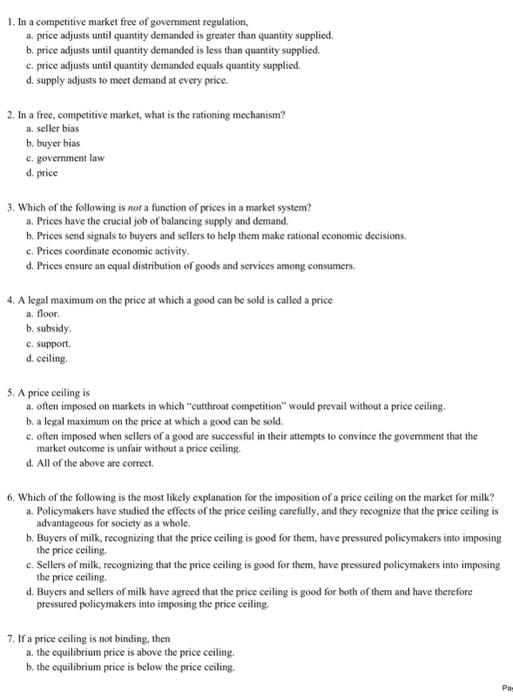Answered step by step
Verified Expert Solution
Question
1 Approved Answer
1. In a competitive market free of government regulation, a. price adjusts until quantity demanded is greater than quantity supplied. b. price adjusts until quantity
1. In a competitive market free of government regulation, a. price adjusts until quantity demanded is greater than quantity supplied. b. price adjusts until quantity demanded is less than quantity supplied. c. price adjusts until quantity demanded equals quantity supplied. d. supply adjusts to meet demand at every price. 2. In a free, competitive market, what is the rationing mechanism? a. seller bias b. buyer bias c. government law d. price 3. Which of the following is not a function of prices in a market system? a. Prices have the crucial job of balancing supply and demand. b. Prices send signals to buyers and sellers to help them make rational economic decisions. c. Prices coordinate economic activity. d. Prices ensure an equal distribution of goods and services among consumers. 4. A legal maximum on the price at which a good can be sold is called a price a. floor. b. subsidy. c. support. d. ceiling. 5. A price ceiling is a. often imposed on markets in which "cutthroat competition" would prevail without a price ceiling. b. a legal maximum on the price at which a good can be sold. c. often imposed when sellers of a good are successful in their attempts to convince the government that the market outcome is unfair without a price ceiling. d. All of the above are correct. 6. Which of the following is the most likely explanation for the imposition of a price ceiling on the market for milk? a. Policymakers have studied the effects of the price ceiling carefully, and they recognize that the price ceiling is advantageous for society as a whole. b. Buyers of milk, recognizing that the price ceiling is good for them, have pressured policymakers into imposing the price ceiling. c. Sellers of milk, recognizing that the price ceiling is good for them, have pressured policymakers into imposing the price ceiling. d. Buyers and sellers of milk have agreed that the price ceiling is good for both of them and have therefore pressured policymakers into imposing the price ceiling. 7. If a price ceiling is not binding, then a. the equilibrium price is above the price ceiling. b. the equilibrium price is below the price ceiling. Pa

Step by Step Solution
There are 3 Steps involved in it
Step: 1

Get Instant Access to Expert-Tailored Solutions
See step-by-step solutions with expert insights and AI powered tools for academic success
Step: 2

Step: 3

Ace Your Homework with AI
Get the answers you need in no time with our AI-driven, step-by-step assistance
Get Started


